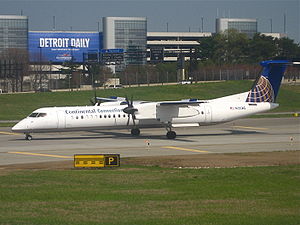
- Image via Wikipedia
A year ago today, on Thursday, February 12, 2009, Continental Connection flight 3407 crashed into a house in Clarence Center, NY. The flight, a Q400 turboprop operated by Colgan Air, killed 45 passengers, 4 crewmembers, and 1 man on the ground. The plane was on approach into Buffalo-Niagara international Airport from Newark’s Liberty Airport.
It was the first fatal crash involving the Bombardier Q400, a descendent of the DeHavilland Dash 8, introduced in 1984. There have been over 1000 of these built to date, including the latest model, the Q400. The Q400 seats an average of 70-78 passengers, and is known as a safe and fuel efficient aircraft for regional service.
The plane stalled only a few miles short of the runway. The NTSB report, released last week, stated the probable cause was the Captain’s reaction in the critical minutes leading up to the crash. The most significant issues were as follows:
- An inadequately trained captain, namely that “his continued weaknesses in basic aircraft control and instrument flying were not identified and adequately addressed.â€
- Colgan Air failed to use all sources of information on flight crew qualifications and performance in determining the fitness of the crew to work at the company.
- Pilot fatigue was a contributing factor, but not necessarily a cause of the accident.
Many feel that corporate decisions on the part of Colgan Air were to blame for this accident. James P Kreindler, who represents 17 of the families who lost someone on the flight, hopes to show that cost-cutting measures directly set into motion the circumstances that caused the crash. Continental, who contracted with Colgan to operate the flight, denies all liability or involvement.
It is a serious problem, as the last six fatal domestic airline accidents involved regional carriers, and pilot performance was cited as a factor in three of them. The safety standards for regional carriers have been brought into question, especially since the industry has shifted to the point that more than half of domestic flights are operated by regional carriers. These carriers insist that their safety levels are no less than any of the major carriers, but with the continued pressure and competition to get contracts to operate regional service, cost-cutting at the expense of safety appears to be a serious problem.
Colgan stated that it has taken steps over the last year to enhance all of its training and hiring programs, but there are still many problems. The NTSB issues recommendations as part of every crash report, and the FAA did revise some of its regulations after last year’s crash. But many experts feel it is not enough.
Every time the average person gets behind the wheel of a car, they have the potential to kill not only themselves, but passengers, other drivers, and pedestrians, as well as cause massive amounts of property damage and suffering. As of October, over 16,000 people died in car accidents in this country. A plane is much more complicated to operate than a car, and requires significantly more training, competence, and concentration.
We mention this for those of you who need something to relate to for it to hit emotionally home what a responsibility it is not only to pilot an aircraft, but that of the company that owns and operates it. There is a reason we require people to prove their vehicles are serviceable and that they are competent drivers. Planes are more complicated and require more to keep safe. If your plane stalls, you can’t pull over to the side of the road and wait for the mechanic.
In the end, we never mean to imply that the pilots of this flight, as well as many regional flights are anything but dedicated professionals who are doing their best. But if they are not sufficiently skilled and trained, as well as taken care of, the airline has no business putting them in the cockpit.
The best way we can honor the memories of those who have died in preventable disasters is to use what we learn to make things safer for all of us.
Related articles by Zemanta
- NTSB final report on Colgan Air crash that killed Maple Valley’s Rebecca Shaw blames pilot response (pnwlocalnews.com)
- Pilots at fault in Continental Express crash, investigators say (cnn.com)
- Safety reforms lag a year after NY plane crash (seattletimes.nwsource.com)
- Evidence pins NY crash cause on pilot errors (seattletimes.nwsource.com)
